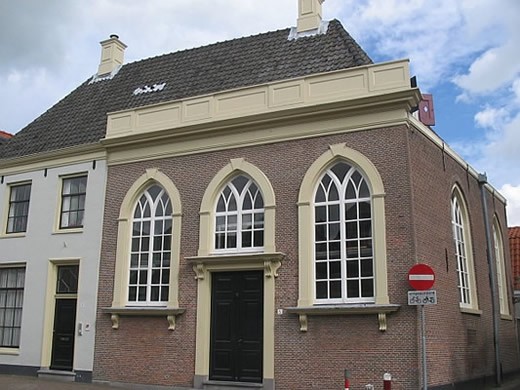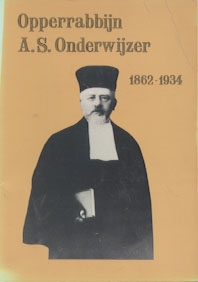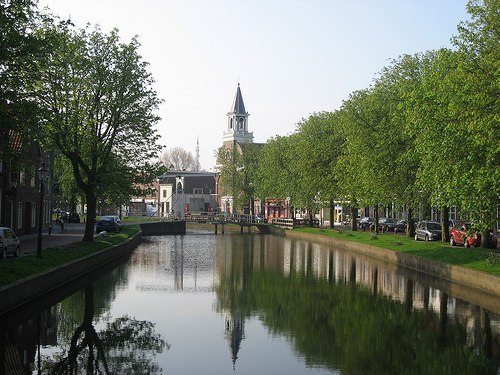The Jewish community of Weesp
Background history
It is a proven fact that Jews have lived in Weesp since 1774 at least. They were mainly Ashkenazi Jews of Central and East European origin. They probably already lived there since 1725-1750 because it was in 1774 they took a synagogue into use. The first official count of the number of Jews took place in 1809, when Louis Napoleon introduced the registration of citizens. At the same time Jews also took on family names. In that year there were 104 Ashkenazi Jews in Weesp and its immediate surroundings. After that the number grew, but later it again diminished. Herewith some numbers:
|
Year |
Jewish population |
Total population |
| 1800 | 141 | |
| 1840 | 153 | 6,500 |
| 1860 | 153 | |
| 1899 | 101 | |
| 1930 | 49 |
The synagogue council in Weesp consisted of 5 members, two of whom were responsible for the care of the poor and one acted as treasurer for donations for the Holy Land.
The most famous member of the community was A.S. Onderwijzer (1862-1934), who would later become Chief Rabbi of Amsterdam. See under “Famous Persons”: Abraham Samson Onderwijzer
Synagogue
The synagogue in the Korte Midden Street, which was taken into use in 1774 was probably a house synagogue. This shows that at that time there already was minyan in Weesp. In 1840 the building was almost collapsing and in any case it had become too small. Therefore, plans were made to build a new synagogue for which, obviously, money had to be collected. Thus, on Friday, October 30th, 1840 the new synagogue in Nieuw Street was inaugurated. Even Chief Rabbi Berenstein of Amsterdam was present and held the service. Other representatives from Amsterdam were Gabriel J. Polak and Cantor S. Frijda. The program also included prayers for the city of Weesp, by which gratitude was expressed to the municipality, which together with the nation and the province had made the building of the synagogue possible. These prayers were contained in a poem, an ‘Evocation’ (“Uitboezeming”), a felicitation in 5 couplets, written by J.W. Berlijn of Amsterdam.
The greatest impact of the inauguration of this synagogue was the fact that the Weesp Synagogue served as a provincial synagogue. The Jewish community of Weesp consisted namely also of the small towns of Muiden, Nederhorst den Berg and Wespercarspel. When the new synagogue was four years old, it became the target of disturbances: On Wednesday, April 10th, 1844 the evening prayers of the Israelites in Weesp were disturbed by the wanton, furious shouting of a group of boys. Thereupon an assemblage of people took place, part of which went through the town and broke into the windows of many Israelites as well as of the synagogue, before the police could put a stop to this.
Also we found on record:
The cause of these disturbances could be found in the false rumors of a single woman, who regarded the innocent game of a few Israelites with some Jewish children in the public street as a mockery of the Christian religion. She had not neglected to spread these rumors together with all kinds of additions and conclusions, especially amongst the lower classes. After this case had been lodged in front the Court of Law in Amsterdam some of the guilty persons received corrective punishment.
Slowly but surely Jewish and non-Jewish relations improved in Weesp - this seems obvious as there was no more mention of any incidents.
In 1878 a new home for the cantor was built. For this purpose the synagogue council bought a parcel of land in the Sleutelsteeg, a narrow alley which ended on one side at the Oude Gracht and on the other side at Nieuw Street, where already since 1774 the synagogue was situated. It was a modest building in a rather somber alley. On the right side of the main entrance the synagogue council had a front stone installed on which mentioned the year 1878 and on top of this 5638 – according to the Jewish year. The Jewish community in Weesp never had its own rabbi and the cantor officiated as head of the Jewish community. In spite of the modest means, this was for him a full-time job. He led the religious services, was active in Jewish charitable societies, he looked after ritual slaughter, kept up relations with the religious leaders in Amsterdam and visited Jewish citizens.
In 1873 rules were made up with stipulations for attending synagogue services. It was forbidden to visit the synagogue improperly dressed, each male visitor above the age of 13 had to have head-gear, during the service talking was forbidden, parents were responsible for the behavior of their children and ‘with each act against one or more of the articles in the Regulations of Order, the synagogue council (after a previous warning) would impose a fine of 1 to 5 guilders, without the church council losing the right to have each disturber of the peace removed from the synagogue building by the police’.
During the Second World War only the ‘Aron Hakodesh’ was saved, all other objects and ornaments have disappeared. After the restauration of the Synagogue in 1984 a plaque was attached in memory of the Jewish community in Weesp. The building was at first used as a garage and later it was the office of the Labour Bureau. In 1997 the building was again taken into use as a synagogue. The dwelling besides it , houses the consulting body for the dialogue between Jews and Christians.
The Jewish School
The Jewish School was situated at Slijt street – a small school which functioned very well. In 1888 23 children attended this school, 12 boys and 11 girls. On Sundays they had lessons from 9 to 12 and from 3 to 5 o’clock. Mondays and Tuesdays they had lessons from 4.30 to 7.30, Wednesdays from 3 to 7 o’clock, etc. The religious school consisted of 3 classes.
The Jewish cemeteries
One of the early restrictive measures for Jews in the Netherlands was that they were not allowed to bury their dead within town borders. This measure from times past is still evident as Jewish cemeteries are situated far beyond the old cities borders. For Amsterdam one can find the cemeteries in Diemen and Muiderberg for Ashkenasi Jews and in Ouderkerk for the Sefardic Jewish. Jews from Weesp were often buried in the cemetery of Muiderberg.
Jewish Societies
Like in other Jewish communities there were several Jewish societies in Weesp, like Gemiloeth Chasadiem which looked after the cleansing and caring of deceased Jews in Weesp. The other society, Tiferes Kehiloseinoe (“The Ornament of our Society”), dealt with more earthly matters, like looking after the inventory of the synagogue and everything that was necessary for the religious services. There was also the ladies’ society, Ma’asim Towim (“Good Deeds”) which dealt with financial support of the poor, maternity care and newly accepted members (persons accepted as members of the synagogue community). There were, however, also Jews who were members of non-Jewish societies in Weesp, like the Oranje Society.
Several members of the Jewish community of Weesp were members of the town council.
Professions
There were not many Jews in Weesp but it is nevertheless worthwhile to shed some light on their occupations. There was a Jewish butcher and his wife ran a shop of fashion goods which went very well. There was also a cattle dealer. There were three junk-dealers who traded in irregular goods like inventories, metals, rags and hides. Before and shortly after World War II the word ‘rag-jew’ was a concept. There also was a Jewish woman with a fruit stall.
A considerable number of Jews in Weesp had textile shops. These shops sold all kinds of things: materials, mattresses, curtain materials, clothes, floor covers and underwear. One son of one of the families was a wireless operator with the merchant marines – the pride of the whole family. There was a tailor and his wife has a milliner’s shop. There was a sweet-shop which also sold ice-cream and there also was a Jewish baker.
The end
During the thirties several Jewish refugee families from Germany came to live in Weesp.
Regretfully the end of the Jewish community in Weesp is well-known. Of the sixty-five Jewish men, women and children only seven returned.
In 1947 the Jewish community of Weesp was merged into one community with Bussum.
Source:
book: Geschiedenis van de Joodse gemeenschap te Weesp.
C 1983 Boekhandel De Ark / Uitgeverij Heureka, Weesp
Druk: Krips Repro, Meppel
ISBN 90 6262 092 2
Extracted from the source:Yael Benlev-de Jong
Translation into English:Nina Mayer
Editing:Ben Noach
Final review:Hanneke Noach
[an error occurred while processing this directive]
[an error occurred while processing this directive]

The Synagogue

Chief Rabbi A.S. Onderwijzer
